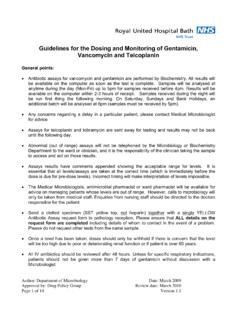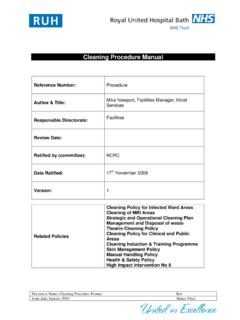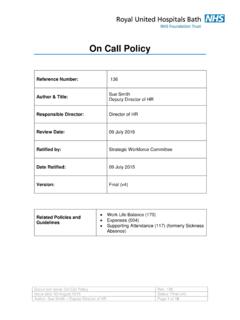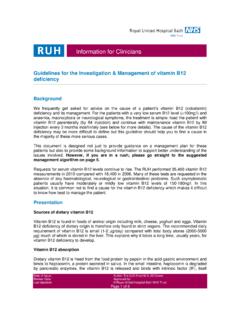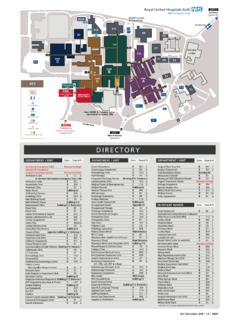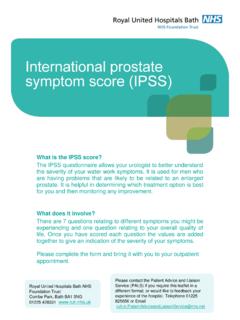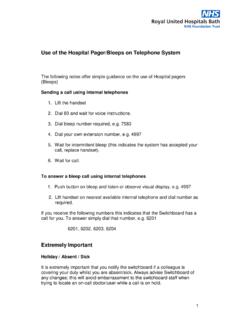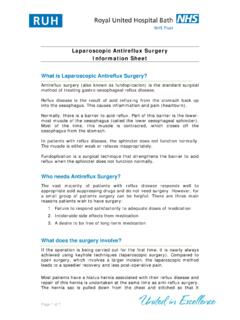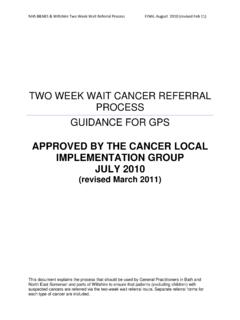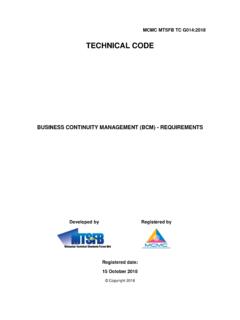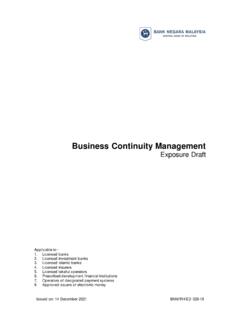Transcription of BUSINESS CONTINUITY PLAN - Royal United Hospital
1 - 1 - Author / Manager Responsible: Alex Massey/Avril Webb Review Date: Reviewed by: Version: Last Edited 01/07/10 Related Documents Major Incident plan , Pandemic Flu plan BUSINESS CONTINUITY plan - 2 - Page no Section no 2 PREFACE 3 3 4 5 6 7 8 9 SECTION 1 BUSINESS CONTINUITY OVERVIEW Purpose of plan Objectives Activation of plan BUSINESS CONTINUITY planning Process Programme Management Identify Critical services Determining Strategies for BUSINESS CONTINUITY Developing and implementing plans Exercising, maintaining and reviewing 14 14 15 15 16 17 SECTION 2 HEATWAVE GUIDANCE Introduction Heat-Health watch system Health guidance Keeping Cool Divisional/Departmental Duties and Responsibilities Trust Management Duties and Responsibilities 21 21 21 22 22 22 23 24 SECTION 3 TELECOMMUNICATIONS FAILURE Introduction Public Telephone Network Failure Incoming staff Outgoing service Action Portering response Two way radio distribution list How to use emergency porters Royal United Hospital Bath NHS Trust BUISNESS CONTINUITY plan CONTENTS - 3 - 30 30 30 SECTION 4 FUEL CRISIS Introduction Communication Emergency response tools 35 38 40
2 42 44 45 48 50 52 53 55 57 58 60 61 63 65 67 69 SECTION 5 ACTION CARDS Viral Diarrhoea and Vomiting Loss of building/facility Loss of vacuum Loss of medical air Loss of supplies Loss of water Loss of oxygen Loss of Nitrous oxide Loss of gas supply (catering) Fire Loss of electricity (site) Loss of steam (catering) Loss of significant plant Loss of water (catering) Loss of Gas (site) Loss of linen Loss of electricity (catering) Loss of steam (site) Loss of food 1 2 3 4 5 6 7 SECTION 6 APPENDICES BUSINESS CONTINUITY Assessment Risk Assessment Matrix Temperature recording Matrix Fluid stocks held in RUH Pharmacy stores Temporary Logo application form Temporary Logo Code of Use IT BUSINESS CONTINUITY Overview - 4 - 1. Preface BUSINESS CONTINUITY is a planned process that endeavours to provide a framework for organisational response to any adverse or disruptive event that may alter normal service provision.
3 BS25999 parts 1&2 define BUSINESS CONTINUITY as Strategic and tactical capability of the organisation to plan for and respond to incidents and BUSINESS disruptions in order to continue BUSINESS operations at acceptable pre-defined levels within agreed time frames. The Civil Contingencies Act (2004) identifies all NHS organisations as Category 1 responders this legislation places the burden of responsibility on such organisations to plan , test and train for response against a range of disruptive challenges. BUSINESS CONTINUITY is required to be robust, with a clearly defined risk assessment, strategy for resilience and strategy for recovery of usual service provision. Royal United Hospital Bath NHS Trust BUISNESS CONTINUITY plan PREFACE - 5 - SECTION 1 OPERATIONAL ARRANGEMENTS Royal United Hospital Bath NHS Trust BUISNESS CONTINUITY plan - 6 - INTRODUCTION Purpose of plan This guidance aims to describe.
4 The BUSINESS CONTINUITY objectives for the Trust How the plan will be activated & alerting procedures Roles and responsibilities The BUSINESS CONTINUITY planning process and the risk assessment process The critical services that require maintaining during an adverse event The recovery process the Trust will undertake following a period of disruption (contained within individual Divisions and Departments BUSINESS CONTINUITY Plans) BUSINESS CONTINUITY plans for certain predictable adverse/ disruptive events such as a fuel crisis or stoppage, loss of communications and management of extreme weather conditions. (contained within the Appendices) Division and Department specific BUSINESS CONTINUITY Plans (Contained within the Appendices) Objectives The primary objective of the Trust BUSINESS CONTINUITY plan is to minimise disruption and speed recovery following adverse events, whether they be internal or external.
5 The Trust BUSINESS CONTINUITY plan is expected to have the ability to be without key utilities for up to three days and restart priority clinical services at seven days (NHS Resilience and BUSINESS CONTINUITY Management Guidance 2008), additionally national guidance insists that the Trust identifies the assets that will need to be available to maintain critical services for the first hour, 24hours, 3 days and for 7 days. The consequences of not having such plans in place may include: Loss of life or irreparable injury Loss of public confidence and adverse publicity Exposure to the potential to legal action Financial penalties It is the ambition of BUSINESS CONTINUITY planning that the Trusts response to disruption is made in a coordinated manner, in which all stakeholders are fully informed of the challenges and solutions to managing the period of disruption.
6 The BUSINESS CONTINUITY plan must also provide for recovery and restoration of normal service thereby avoiding additional financial penalties or loss of public confidence following a period of disruption. Additionally the Trust must ensure at an early stage the engagement of external distributors and suppliers to ensure that their BUSINESS CONTINUITY arrangements are in place. This will entail BUSINESS CONTINUITY Royal United Hospital Bath NHS Trust BUISNESS CONTINUITY plan SECTION 1 OPERATIONAL ARRANGEMENTS - 7 - being agreed with suppliers at the commissioning and contracting stage of negotiation and engagement. BUSINESS CONTINUITY is also an essential component of the external review and monitoring performed by the Standards for Better Health and is now a British Standard BS25999 which provides both a code of practice and certification.
7 Activation of the plan Other than for training purposes, it is intended that this plan is activated whenever there is an internal or external event that causes disruption or interruption to services. This may be in the form of energy shortages, water or food restrictions, strike action or pandemics etc. The plan will be activated by the Executive Team (ET) in direct consultation with the Emergency planning Lead. It is likely that the alert to an external disruptive event will be communicated by the LRF eg. Fuel shortages. Alert to an internal event may be triggered by any member of staff, patient or visitor. When responding to an internal disruptive event it may only be necessary to initiate part of the BUSINESS CONTINUITY plan . Equally an internal alert to a disruptive event that may require activation of the BUSINESS CONTINUITY plan may escalate to affect partner agencies.
8 Communication with all partners is therefore of paramount importance. It will be at the discretion of the LRF and ET whether the disruptive event that has required activation of the BUSINESS CONTINUITY plan also warrants that activation of the Major Incident plan and in the case of a pandemic or other highly infectious diseases the activation of the Pandemic Flu plan . The command and control structure is shown below. Figure and Control arrangements for the activation of the BUSINESS CONTINUITY plan LRF RUH ET EMERGENCY planning LEAD Dept of Health Internal Alerter Activation of Pandemic Flu plan Activation of BCP Activation of Major Incident plan - 8 - BUSINESS CONTINUITY planning Process The NHS Resilience and BUSINESS CONTINUITY Management Guidance 2008 describes 5 key stages in the BUSINESS CONTINUITY planning process these are: Programme management; establish and maintain BUSINESS CONTINUITY capability Understanding your BUSINESS ; identify critical services, recovery priorities and assess risks that could disrupt service provision Determining BUSINESS CONTINUITY strategies.
9 Identifying the alternative strategies available to mitigate loss Developing and implementing a BUSINESS CONTINUITY response; develop plans, procedures, education, training and awareness Exercising, maintaining and reviewing; ensuring plans are fit for purpose, updated and quality assured. Figure 2. The BUSINESS CONTINUITY planning Cycle Understanding BUSINESS CONTINUITY capability Identifying BUSINESS CONTINUITY strategies Maintain and review Understanding the BUSINESS Develop response - 9 - Programme Management The NHS Resilience and BUSINESS CONTINUITY Management guidance 2008 identifies the Chief Executive of the Trust as having responsibility for ensuring that there is a BUSINESS CONTINUITY plan in place that will confidently address the needs of the Trust as per the CCA 2004.
10 It is therefore imperative that BUSINESS CONTINUITY is achieved at every level of the organisation. All participants must be familiar with and have a responsibility and commitment towards ensuring its success. BUSINESS CONTINUITY must become part of every manager s normal daily responsibility. The inclusion of BUSINESS CONTINUITY as a standing agenda item must become usual practice at relevant divisional and departmental meetings. Within the Trust the Director of Patient Care delivery holds executive responsibility for ensuring that the Trusts BUSINESS CONTINUITY plan is robust, resilient, and can be readily activated. It is each Divisions responsibility to ensure that every ward and department has a BUSINESS CONTINUITY plan , and that such plans are regularly tested and reviewed. These plans can be found at Appendix 5 Within the remit of all managers within the Trust it is vital that BUSINESS CONTINUITY becomes embedded into daily work streams.
